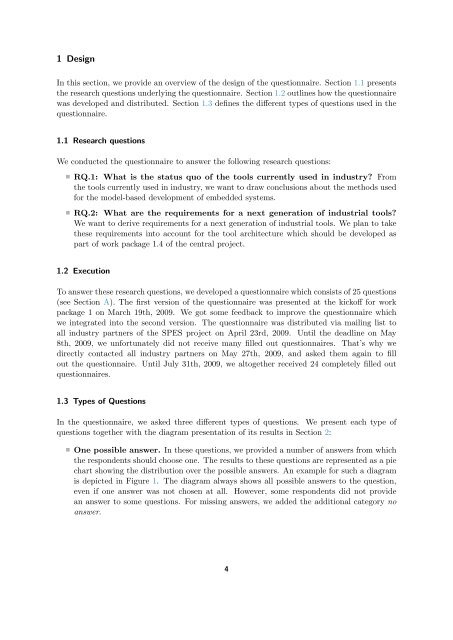SPES 2020 Deliverable 1.4.B-1 Result of the Tool Questionnaire
SPES 2020 Deliverable 1.4.B-1 Result of the Tool Questionnaire
SPES 2020 Deliverable 1.4.B-1 Result of the Tool Questionnaire
Create successful ePaper yourself
Turn your PDF publications into a flip-book with our unique Google optimized e-Paper software.
1 Design<br />
In this section, we provide an overview <strong>of</strong> <strong>the</strong> design <strong>of</strong> <strong>the</strong> questionnaire. Section 1.1 presents<br />
<strong>the</strong> research questions underlying <strong>the</strong> questionnaire. Section 1.2 outlines how <strong>the</strong> questionnaire<br />
was developed and distributed. Section 1.3 defines <strong>the</strong> different types <strong>of</strong> questions used in <strong>the</strong><br />
questionnaire.<br />
1.1 Research questions<br />
We conducted <strong>the</strong> questionnaire to answer <strong>the</strong> following research questions:<br />
RQ.1: What is <strong>the</strong> status quo <strong>of</strong> <strong>the</strong> tools currently used in industry? From<br />
<strong>the</strong> tools currently used in industry, we want to draw conclusions about <strong>the</strong> methods used<br />
for <strong>the</strong> model-based development <strong>of</strong> embedded systems.<br />
RQ.2: What are <strong>the</strong> requirements for a next generation <strong>of</strong> industrial tools?<br />
We want to derive requirements for a next generation <strong>of</strong> industrial tools. We plan to take<br />
<strong>the</strong>se requirements into account for <strong>the</strong> tool architecture which should be developed as<br />
part <strong>of</strong> work package 1.4 <strong>of</strong> <strong>the</strong> central project.<br />
1.2 Execution<br />
To answer <strong>the</strong>se research questions, we developed a questionnaire which consists <strong>of</strong> 25 questions<br />
(see Section A). The first version <strong>of</strong> <strong>the</strong> questionnaire was presented at <strong>the</strong> kick<strong>of</strong>f for work<br />
package 1 on March 19th, 2009. We got some feedback to improve <strong>the</strong> questionnaire which<br />
we integrated into <strong>the</strong> second version. The questionnaire was distributed via mailing list to<br />
all industry partners <strong>of</strong> <strong>the</strong> <strong>SPES</strong> project on April 23rd, 2009. Until <strong>the</strong> deadline on May<br />
8th, 2009, we unfortunately did not receive many filled out questionnaires. That’s why we<br />
directly contacted all industry partners on May 27th, 2009, and asked <strong>the</strong>m again to fill<br />
out <strong>the</strong> questionnaire. Until July 31th, 2009, we altoge<strong>the</strong>r received 24 completely filled out<br />
questionnaires.<br />
1.3 Types <strong>of</strong> Questions<br />
In <strong>the</strong> questionnaire, we asked three different types <strong>of</strong> questions. We present each type <strong>of</strong><br />
questions toge<strong>the</strong>r with <strong>the</strong> diagram presentation <strong>of</strong> its results in Section 2:<br />
One possible answer. In <strong>the</strong>se questions, we provided a number <strong>of</strong> answers from which<br />
<strong>the</strong> respondents should choose one. The results to <strong>the</strong>se questions are represented as a pie<br />
chart showing <strong>the</strong> distribution over <strong>the</strong> possible answers. An example for such a diagram<br />
is depicted in Figure 1. The diagram always shows all possible answers to <strong>the</strong> question,<br />
even if one answer was not chosen at all. However, some respondents did not provide<br />
an answer to some questions. For missing answers, we added <strong>the</strong> additional category no<br />
answer.<br />
4
















